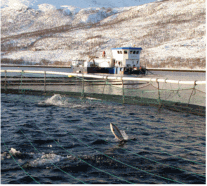
As well as enhanced quality of life in human beings, physical exercise can also have a preventative effect against cardiovascular diseases, high blood pressure and osteoporosis. Regular training strengthens immune defence and leads to increased life expectancy. Physical fostering of farmed salmon improves the growth rate of the fish and better equips them to cope with disease. Molecular genetic studies show that physical training influences parts of the salmon’s immune system and amongst other things reduces the its inflammation level.
Increases robustness
Two projects about aerobic stamina training of salmon were initiated by the Fisheries and Aquaculture Industry Research Fund (FHF). Scientists from Nofima Marin, the Norwegian Institute for Water Research (NIVA), the Norwegian School of Veterinary Science (NVH) and NTNU’s Faculty of Medicine, in collaboration with Aakvik Settefisk, have studied whether physical training of presmolt gives a more robust salmon.
The results of a bath challenge test for infectious pancreatic necrosis (IPN) show that the group that had completed six weeks’ of swimming exercise had a survival rate that was more than 10 per cent better than the control group. This is the first study that shows that physical training increases disease resistance in fish.
The study also showed that fish that had undergone training had significantly better growth rates than fish that had not undergone training.
Further, the study confirms the general perception that smolt quality is extremely important for the salmon’s performance when transferred to sea cages, as the fish will be exposed to greater disease and environment-relates challenges there than is the cases at land-based fish farms.
Improves disease resistance
In human beings, research has shown that physical exercise strengthens the immune system by reducing the basic inflammation levels in the body. A high inflammation level gives lower resistance against diseases, and leads to increased risk of developing cardiovascular diseases.
The fact that fish that that were subjected to physical exercise as presmolt salmon cope better in a challenge test than fish that have not undergone such swimming exercise indicates that the physical training has had a positive effect on the immune system of the fish.
The body’s inflammation level is to a high degree reliant on a group of molecules called cytokines. The cytokines are signalling molecules or, in other words, are used for cellular communication. As well as contributing to regulating the inflammation level, the cytokines influence the activity level in other parts of the immune system. In accordance with research carried out on human beings, the studies showed that physical exercise reduces the base level of three specific inflammatory cytokines (TNFa, IL-1ß and IL-6).
Studies of 1800 genes showed that other parts of the immune system were positively influenced by physical training. At the molecular genetics level, the exercise gave effects that can strengthen the immune response and contribute directly in the ability of the fish to fight disease. It was also found that fish which had undergone training had higher levels of genes that can reduce so-called oxidative stress (an imbalance in the body that can cause cell and tissue damage).
Consequently, the molecular genetic studies substantiate the results from the challenge test and support the conclusion that training has a positive influence on the immune system in fish.
Training programme must be optimised
Given that the research has shown that training is beneficial for farmed fish, the next questions will be how much, how often, how hard and in which way fish should be trained.
Overtraining is a well known term within the field of exercise physiology. The concept of overtraining means that the body has insufficient time to recover between training sessions. This can lead to a chronic inhibition of the immune system and increased inflammation levels in the body. Provisional results indicate that the salmon can also be over trained.
It will, therefore, be extremely important during the ongoing research work to find optimal training programmes so that salmon of different sizes can train with the intensity and duration that gives the best robustness. This work is well underway in a follow-up project FitnessFish, which is supported by the Research Council of Norway and FHF.
Tank design and flow pattern
Methodology for three dimensional flow measurements has been successfully developed and implemented on a commercial scale. Evaluations carried out in production tanks of different designs clearly show that the flow pattern in a tank is extremely complex, and that it is influenced by several different parameters. The placement and adjustment of special inlets and outlets can be decisive.
In the years ahead, it will be important to develop documentation and technical solutions to ensure optimal flow settings for different sizes of fish.
Commercialisation of knowledge
The industry is expressing great interest in more knowledge about how exercising of fish can strengthen their robustness. Consequently, a reference group has been established, comprising representatives from Lerøy Hydrotech, Marine Harvest, Åsen Settefisk AS, Salmar, Firdagruppen, Sjøtroll and the Norwegian Seafood Federation (FHL).
Exciting initiatives have also come from equipment manufacturers, while the company OptoSwim has launched a lighting system that influences the optomotoric response of fish, such that it is stimulated to exercise in the farm cages. Collaboration with the industry will be continued in the follow-up project FitnessFish in order to secure the transfer of knowledge and increased added value. Such reciprocal transferring of knowledge between industry and research institutes is decisive if the research results are going to contribute to increased added value.


